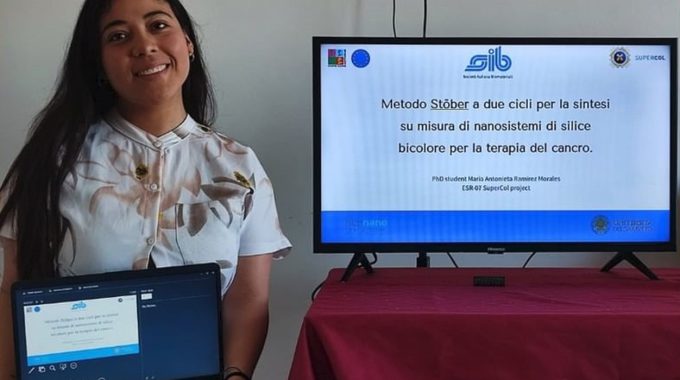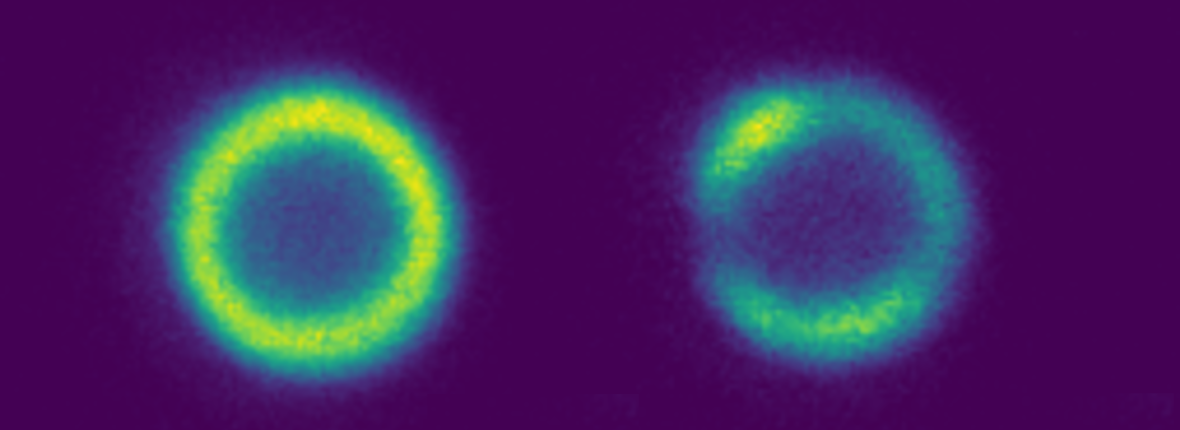
SuperCol achieves exciting results in advancing functional colloidal nanoparticles
With the project well underway, SuperCol is happy to report appealing results in the science of functionalized colloids and nanoparticles. Thanks to the use of super-resolution microscopy, fundamental insights have been obtained and novel features have come to light. Research is ongoing and papers are currently being prepared, but here we already provide a few notable examples as a concise ‘sneak preview’. It illustrates the progress in SuperCol’s second work package, aimed at advancing the synthesis and responsivity of the nanoparticles.
At the focus of the SuperCol project are particles of microscopic or even nanoscopic size that have bio-active molecules such as DNA attached to their surface. Such ‘functionalized colloids’ are able to interact with biomolecules in a sample, or to interact at a cellular level – for instance binding to membrane receptors. With a clever design, they can be used to develop powerful diagnostic and therapeutic systems. Think dedicated biosensors (for instance for Covid19 and cholera) or targeted drug delivery systems (for instance cancer therapeutics).
Bridging the knowledge gap
This potential has sparked lots of interest in functional colloids across the globe. However, since much is unknown about their design, synthesis and use, often a lot of trial-and-error is involved in their preparation. This is the knowledge gap SuperCol wants to bridge. At the heart of the project is super-resolution microscopy, a set of advanced techniques in optical microscopy able to reveal molecular details with the help of so-called ‘fluorophores’: fluorescent molecular entities that are chemically coupled to molecules of interest.
Initially developed for the domain of cellular and molecular biology, super-resolution microscopy also has great potential for the field of functionalized colloids. It can help extract information such as
How many functional molecular groups are actually present at the surface of the colloids?
Are they neatly distributed, are they in clusters, or maybe just on one side of the particle?
And even more in detail: do they retain their structure, or do they change their shape and maybe lose functionality?
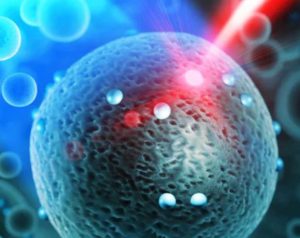
Thus, SuperCol hopes to enable an intelligent approach based on scientific foundations: establishing the principles, developing protocols to deliberately realize specific functionalities.
At the forefront
As reported in an earlier article on the SuperCol website, before super-resolution methods could be used for the study of nanoparticles specific imaging issues had to be resolved. Nanoparticles can induce several photonic effects interfering with the fluorescence measurements, which has long hampered the application of supermicroscopy in studying the surface chemistry of colloids. This impasse has now been overcome and according to Prof. Frank Scheffold, principal investigator and leader of the work package, SuperCol is at the forefront in applying super microscopy tools in the nanoparticles domain. Scheffold leads the Soft Matter & Photonics group at the University of Fribourg, which was among the first to study the use of super-resolution microscopy in soft systems outside the biological realm. “Given the progress made, SuperCol is truly a leading effort in advancing these methods in the field of nanoparticles and materials.”
In particular, substantial results have been obtained in the quantification of functional groups on particles. With this, Prof. Ilja Voets of Eindhoven University of Technology is closely involved. “Super-resolution microscopy offers a great opportunity – for some particle types perhaps the only opportunity – to very accurately map the functionalized interface, and establish how it varies from particle to particle. This information helps us to optimize their syntheses or adjust their design.”
Precise monitoring of functionalisation
As an example, Voets refers to research performed by SuperCol PhD candidate Bahar Rouvand, who studies nanoparticles functionalized with short DNA fragments. These can ‘recognize’ other DNA strands via hybridization, so that these particles can be used for sensing purposes. “We have established a method to determine precisely how much DNA actually ends up grafted on individual particles, and whether it is homogeneously distributed across their surface. We have encountered big differences between individual particles regarding the amount of DNA, but also concerning its distribution. We are now trying to understand how that depends on the way we make and functionalize the colloids.”
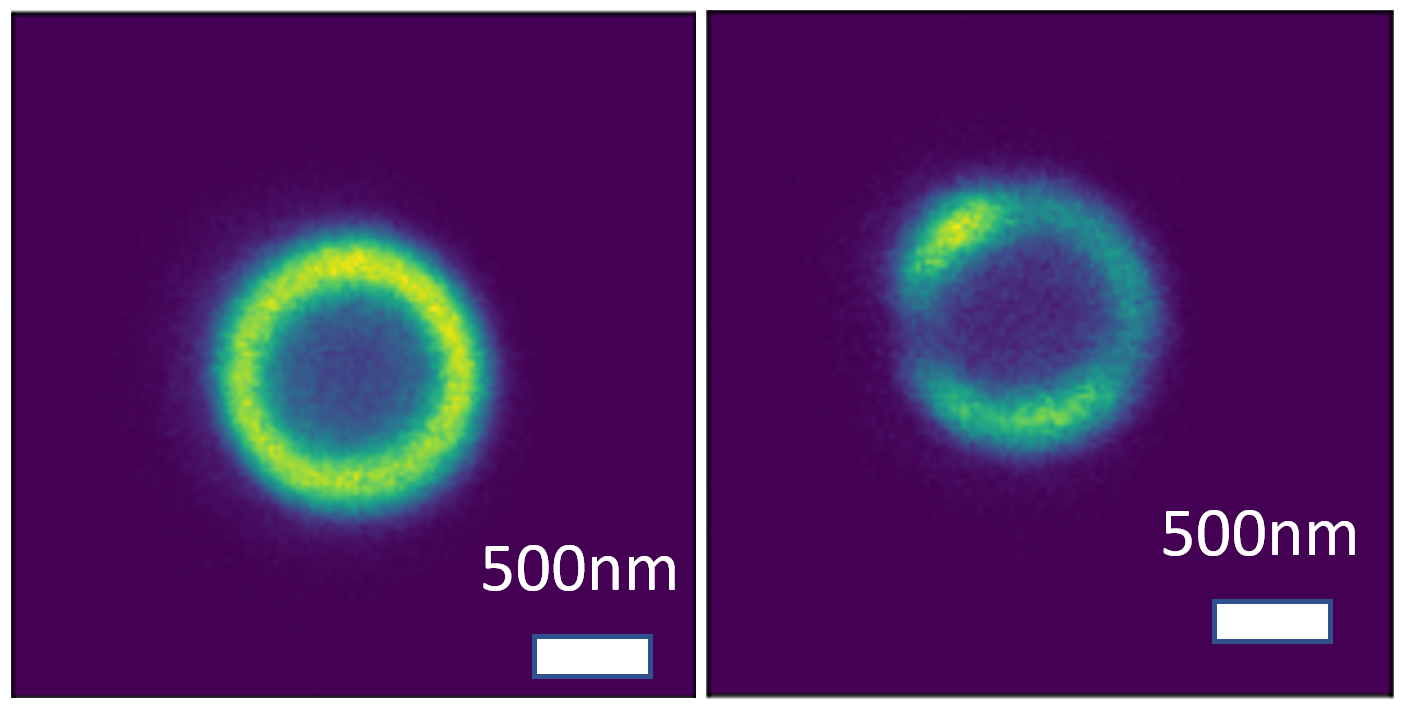
Homogeneous (left) and heterogeneous (right) distribution of functional groups on nanoparticles, as established with superresolution microscopy.
Being able to study individual particles is key here, underpins Voets: “With the common ensemble characterization, the variability within and among particles disappears in the overall average.” There’s also a very practical side to this, she mentions: “We have discovered big differences between particles that were supposed to have the same properties. So when you buy nanoparticles, it is really important to first confirm exactly what the properties are of the batch of particles you have on hand.”
Less is more
In another study investigating the performance of gold nanoparticles coated with DNA for sensing purposes, an intriguing phenomenon has come to light. When increasing the DNA density, at some point ‘over functionalization’ occurs. This was established in experiments in the group of SuperCol coordinator Dr. Peter Zijlstra at Eindhoven University of Technology and confirmed through simulations by SuperCol PhD candidate Rodrigo Rivas Barbosa, supervised by PIs Dr. Emanuela Zaccarelli and Prof. Francesco Sciortino at Sapienza University Rome. The research reveals an optimum in terms of DNA density. Beyond that density, the functionality of a particle changes dramatically. The explanation is that the DNA strands get in each other’s way, which compromises the binding properties of the particle.

Zijlstra: “This ‘less is more’ effect was rather unexpected. In the literature, the prevailing approach is to functionalize the particles as densely as possible. We now show that this doesn’t always make sense. You could say that functionalization protocols have become so good that we arrive at a regime where they can work against us.”
Responsive particles
Another SuperCol feat that Zijlstra is excited about is the development of responsive particles, where the functionality can be tuned with light or with chemical cues. For instance, PhD candidate Bárbara Malheiros in the Voets lab has devised DNA strands that change conformation under the illumination. She has demonstrated that the functionality of particles coated with such DNA can be changed using light. And PhD candidate Xhorxhina Shaulli at the Scheffold group has been able to design particles where a change in pH induces a change in functionality. Zijlstra: “This design of responsive particles is what we planned to do in our proposal and we are really very well on our way here.”
Microgels on surfaces
Zijlstra mentions that although research is still ongoing, all deliverables in the second work package have been met. Detailed results cannot be shared yet, as the first papers are awaiting publication and others are being prepared. However, one striking result has already been published in ACS Nano, a high ranking journal of the American Chemical Society. PhD candidates Shaulli and Rivas Barbosa studied spongy microgel nanoparticles using super resolution microscopy and revealed a dramatic effect: when the surface supporting the particles is hydrophilic, the particles are nicely spherical. However, on a hydrophobic surface they flatten into an egg-like shape.
The paper establishes a foundation for investigating microgels and other related particle systems. Scheffold: “It combines materials aspects, application potential, theory, modeling, and super resolution microscopy – so basically everything that we have in the SuperCol project.”
The particles that are about half a micron (800-850 nm) in size were imaged with a resolution of 30 nanometer. “We found that the behavior near the surface depends a lot on the surface properties. The data obtained with the study enabled Rivas Barbosa and Zaccarelli to develop a quantitative model. So now we can describe and predict how it behaves near a surface.” That of course is relevant if you use these particles in a coating for a diagnostic sensor, a delivery system or any other application.
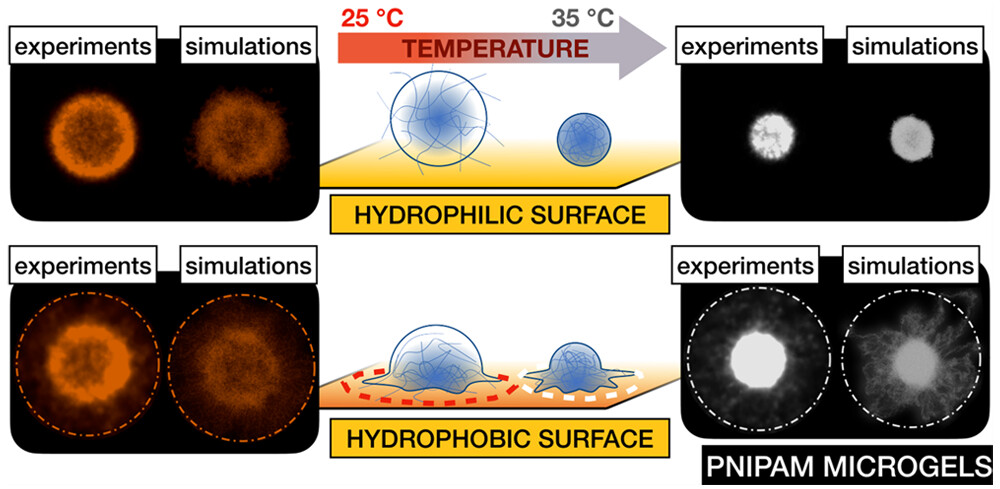
“We can not only describe how they behave at the surface but also how they swell and contract as a function of temperature – which is a unique feature of this material.” In fact, Scheffold says, this type of microgel particle is one of the most studied types of colloids because of its unique properties. Since it consists of a spongy gel network it can be used to take up, carry and deliver all kinds of molecules. Or it can be functionalized and used for instance as a sensing particle. “It’s already used in many different applications. For instance nicotine patches are often based on a hydrogel system.”
Building a trust base
To Scheffold the examples mentioned above underpin the success of SuperCol’s approach in bringing super resolution microscopy to the soft matter domain. He emphasizes the relevance of building a trust base among the soft matter community since this consists primarily of materials researchers and physical chemists that are accustomed to applying characterization technology ‘off the shelf’. “I am often asked how we really know what we are measuring. This is a relevant concern, since detecting fluorescence is in fact an indirect method. We can’t really ‘see’ the material itself. We already see how SuperCol is of value here, contributing with method development and technology verification. I think the timing of SuperCol is perfect to increase trust in super-resolution tools that are increasingly coming into the sights of the soft matter community.” Zijlstra adds that in the third SuperCol work package, the obtained results are further integrated into applications. This runs parallel to the studies of the second work package, he says. “Of course, the more you know about the fundamentals, the better. But we don’t wait for that. Applications such as biosensors and drug delivery systems are already being developed and improved based upon the knowledge we have gained.”
I think the timing of SuperCol is perfect to increase trust in super-resolution tools that are increasingly coming into the sights of the soft matter community.


